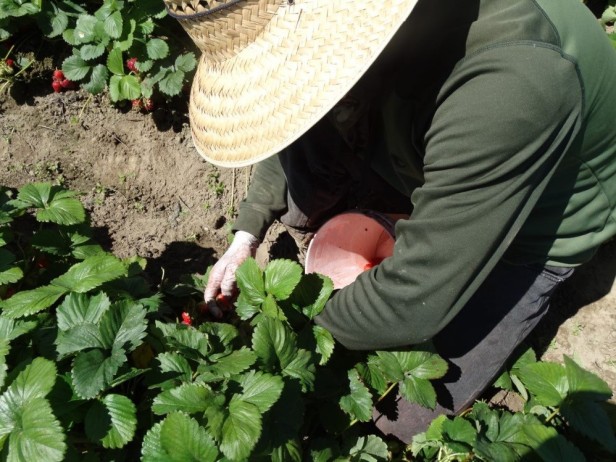When you bite into a strawberry, do you ever wonder whose fingers grasped it as they pulled it off the vine? What kind of conditions that person worked in? What hazards they were exposed to?
If so – we have the answers!
A strawberry picker – like any other farmworker – is extremely quick and efficient. For example, did you know that some farmworkers pick strawberries right into the clamshell? This means that all the berries in your fridge could have come from one farmworker! In fact, on certain farms, the picker is responsible for packing strawberries as appealingly as possible: bottoms-up with the reddest part of the berry showing. One journalist for the LA Times likened it to “a game of Tetris from hell.” The berries are of varying shapes and sizes, so it can be an intellectual challenge to figure out how to fit them all together in the clamshell.
The mechanics of strawberry picking: strawberries grow low to the ground, so farmworkers have to pick them while in a stooped or bent position, which puts great strain on their backs. Picking can last upwards of 12 hours at a time and goes on for weeks, if not months, which spells permanent spinal and nerve damage for many. One 26-year-old farmworker was quoted by ThinkProgress as saying, “My back aches as if I was very old… When there’s lots of fruit in the fields, they turn on the lights of all the buses when there’s no more sunlight so people can keep working.” When a group of farmworkers was asked which crop they liked picking the least, they said, strawberries.

The hazards: The strawberry season lasts the longest in fair-weather states – that’s why 91% of strawberries come from California and Florida, according to USDA’s National Agricultural Statistics Service. In fact, California’s strawberry season extends almost year-round. Strawberries do not like freezing temperatures or the rain, as they are a delicate fruit that ripens best in warm, dry conditions. Even so, temperatures in the strawberry fields can range from very hot to very cold. And, when there’s rain in the forecast or just lots of fruit to pick, the pace of the picking intensifies – which increases the likelihood of injury.

Keep in mind that, even though berries aren’t damaged if the temperatures remain above freezing, 33º+ still feels cold to the farmworker, and can cause symptoms of cold stress. And then when temps climb into the triple-digits during picking season, farmworkers are put at great risk of heat illness and excessive UV ray exposure.
Pesticides present a clear danger in strawberry fields as well – more than almost any other kind of produce. Year after year, the Environmental Working Group rates strawberries in the first or second slot for amounts of pesticide residue, saying that “strawberry growers use jaw-dropping volumes of poisonous gases to sterilize their fields before planting, killing every pest, weed and other living thing in the soil.” Consumers already worry about the pesticides they consume when eating conventionally-grown strawberries. Imagine the amount of pesticide residues a farmworker is exposed to, when they pick thousands of them.

The dangers of heat stress and pesticide exposure are well-known to AFOP Health & Safety – that’s why we provide free training to farmworkers through our network of trainers, all across the country, to educate farmworkers on how to keep themselves safe in the fields and in the strawberry patch. Strawberry pickers have also benefited from our long-sleeved shirt drive, which provides free long-sleeved shirts that will better protect farmworkers’ vulnerable skin, back, and neck from pesticides and UV damage.
What other fruit or vegetable are you curious about? Leave us a comment and we’ll look into it for you!
Did you enjoy this blog? You might also like:

